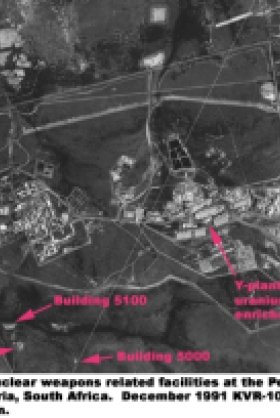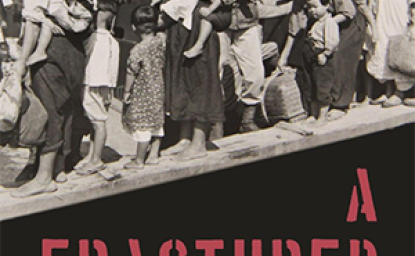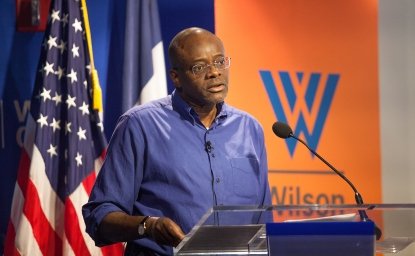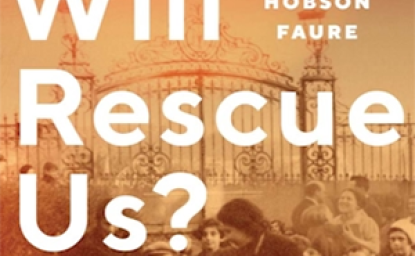Intelligence Reports and Estimates of Nuclear Proliferation History Since 1966


China May Have Helped Pakistan Nuclear Weapons Design, Newly Declassified Intelligence Indicates
CIA in 1977 Correctly Estimated South Africa Could Produce Enough Weapons-Grade Uranium “to Make Several Nuclear Devices Per Year”
Report on the Libyan Nuclear Program Found that “Serious Deficiencies,” “Poor Leadership” and Lack of “Coherent Planning” Made it “Highly Unlikely to Achieve a Nuclear Weapons Capability “Within the Next 10 years”
Intelligence Estimates on Argentina and Brazil Raised Questions About Their Nuclear Programs and Whether they Sought a Weapons Capability
Washington, D.C., April 25, 2013 – China was exporting nuclear materials to Third World countries without safeguards beginning in the early 1980s, and may have given Pakistan weapons design information in the early years of its clandestine program, according to recently declassified CIA records. According to a 1983 Special National Intelligence Estimate, intelligence information collected in 1982 raised the “possibility that China has provided [to Pakistan] a fairly comprehensive package of proven nuclear weapon design information.” This formerly Top Secret report, published today by the National Security Archive and the Nuclear Proliferation International History Project, represents the CIA’s first-ever declassification of allegations that Beijing supported Islamabad’s nuclear ambitions.
Image: Khushab plutonium production reactor, Pakistan, 1998 (Photo from spaceimaging.com, courtesy of the Institute for Science and International Security)
The newly released records, obtained under the Freedom of Information Act and Mandatory Declassification Review process, indicate growing U.S. concern from the 1960s to the early 1990s about the intentions of other embryonic or potential nuclear states, including Brazil, Argentina, South Africa and Libya. Among the disclosures in these reports:
- A 1966 estimate discussed what would become an important problem: the possibility of “covert” nuclear programs and the prospect that a “country could go far toward a weapons program” under the disguise of a “peaceful program.”
- On South Africa, a 1977 CIA analysis of the uranium enrichment plant at Valindaba included the estimate that South Africa would be able to produce enough weapons-grade uranium “to make several nuclear devices per year.”
- According to a 1982 estimate, nuclear proliferation could become a “greater threat to US interests over the next five years.” Nuclear R&D alone, without producing any weapons, could contribute to regional instability and the “disruptive aspect of the proliferation phenomenon will constitute the greater threat to the United States.”
- In 1981, U.S. intelligence became aware of a “secret nuclear facility” at Pilcaniyeu that the Argentines later announced was a uranium enrichment (gaseous diffusion) pilot plant.
- An Special National Intelligence Estimate (SNIE) prepared after the 1982 Argentine-British conflict over the Falkland Islands professed “great uncertainty” over Argentina’s nuclear intentions: “emotionally” the Argentine military leadership was interested in a weapons option, but it had “reduced capability to fulfill this desire.” By 1985, uncertainty had passed: U.S. intelligence believed that Argentina had no program to develop nuclear weapons.
- According to the estimates on Brazil, the leaders of the nuclear establishment sought to “keep … options open to develop a nuclear weapons capability.” The 1985 estimate asserted that the prominent role of the Brazilian military in nuclear activities, “the direction of Brazil’s nuclear r&d,” and the “reputation” of the National Nuclear Energy Commission’s president for “favoring a nuclear option” all posed a “danger to US interests.”
- A report on Indian efforts to purchase nuclear-related supplies in world markets described it as a “direct challenge to longstanding US efforts to work with other supplier nations … for tighter export controls” over sensitive technologies. Japan and Western Europe resisted U.S. pressure by arguing that “they will be replaced by the Soviets in the Indian market if they are curtailed.”
- The analysis of the Libyan nuclear program was severe: the program’s “serious deficiencies,” including “poor leadership” and the lack of both “coherent planning” and trained personnel made it “highly unlikely the Libyans will achieve a nuclear weapons capability within the next 10 years.”
Since its inception, the U.S. intelligence community has been investigating and analyzing overseas nuclear activities, whether explicitly weapons-oriented or simply suspicious.[1] At the heart of the earliest effort was the monitoring of the former Soviet Union and its European allies for signs of a weapons program. Beginning in the late 1950s, however with concern about France, China, Israel, and other countries mounting, the Central Intelligence Agency began to focus on global trends. While the CIA has declassified dozens of National Intelligence Estimates (NIEs) on the former Soviet Union and its nuclear forces, NIEs and other detailed reports on proliferation issues have been relatively scarce, especially for the 1970s and 1980s, and often heavily excised. Nevertheless, the Agency has been taking a more forthcoming approach to nuclear proliferation intelligence and the releases are significant. NIEs have had the reputation, sometimes disputed, of being the most authoritative intelligence product on a given topic and their declassification is important for understanding how the intelligence establishment understood this problem during various time periods.[2]
These intelligence estimates alert us to the challenge of interpreting the motives of other countries. Some of the estimates present a rather pessimistic view of the future of the nuclear nonproliferation system, raising questions about the intentions of countries that did not actually seek a nuclear weapons option. With more information available from overseas archives and other sources it is becoming possible to evaluate the acuity of U.S. intelligence analysis for understanding nuclear motivations. For example, new sources in Brazil indicate that the country’s leadership did not want a weapons capability but aimed instead for major accomplishments in advanced technology. Like Iran today, Brazil had initiated a gas centrifuge program (although without the international opprobrium). Nevertheless, the NIEs pointed to a "determination" to have a weapons option, although it also more accurately cited the quest for technological progress. Indeed, Brazil and Argentina, another suspect country, eventually signed off on the Nuclear Nonproliferation Treaty despite longstanding objections (which persist in Brazil). Determining the intentions of the leadership in such countries as Iran and North Korea remains a continuing and important challenge because the outcome will have profound implications for the future of the nonproliferation system. Declassified NIEs can serve as a primary source data set for illuminating contemporary proliferation controversies and for drawing lessons from earlier ones.
Except for a few items, the CIA released these documents as a result of Freedom of Information and mandatory declassification review requests by the National Security Archive. Some of the estimates appear on the CIA FOIA Web site and the editor of this posting requested a new review to see if more information would be declassified. In some cases, that happened: the CIA released more details, for example, on Argentina and Brazil. In some instances, as in Pakistan, the CIA released no new information and the estimates are under appeal. Other pending requests and appeals, if successful, will illuminate CIA and intelligence community perspectives on the problem of nuclear proliferation.
Document 1: “Covert Programs”
National Intelligence Estimate, “The Likelihood of Further Nuclear Proliferation,” NIE 4-66, 20 January 1966, Secret, Excised copy, released on appeal by Interagency Security Classification Appeals Panel
Source: Mandatory Declassification Review request. Obtained and contributed by William Burr.
This estimate, previously released in massively excised form, updated an estimate (NIE-4-2-64) published in 1964 of the nuclear proliferation problem. That estimate, like this one, overestimated the likelihood of an Indian bomb, while somewhat underestimating Israel’s program. This assessment followed the same pattern—predicting India would produce a weapon within a “few years” and also putting Israel in the “might” category, although treating it as a “serious contender” nonetheless. Sweden was also in the “might” category, although the estimators acknowledged the strong opposition of public opinion to a weapons program. Why Israel was in the “might” category, even though it would have weapons by mid-1967, must have reflected debate among U.S. government experts as to the purposes of the Dimona reactor.
The estimate ruled out nuclear programs by a number of countries (Belgium, Denmark, Italy, etc.) for the “foreseeable future,” while it found that other countries “warranted more detailed discussion” because their “incentives” could be strong enough to acquire nuclear weapons in the next 10 years. In addition to India, Israel, and Sweden, these included Japan and South Africa, among others. For plausible reasons (lack of incentive and ample disincentives) the estimate ruled out Italy from the second list, but it is worth noting that in early 1967 its top officials were so angry about the Nuclear Nonproliferation Treaty that they briefly debated whether to initiate a national nuclear weapons program.[3]
A short discussion of the “snowball effect” (later known as “proliferation cascades” or “chains”) suggested that the United Arab Republic (Egypt-Syria) and Pakistan were likely to take the nuclear option should India or Israel go nuclear. The snowball effect could be limited by various considerations; for example, if close allies such as Japan or West Germany felt the pressure, they were less likely to go nuclear if the United States “strongly opposed” it. An interesting but heavily excised section on “The Detection of Covert Programs” is the first time that an NIE on nuclear proliferation addressed this problem at length, although the possibility had long been known. This section includes deletions on intelligence capabilities and U.S. efforts to inspect Israel’s Dimona reactor. In this connection, the estimate treated the “ultracentrifuge process” as a “feasible” source of weapons-grade uranium where an enrichment plant could be “built and operated without attracting attention.” Unlike some of the earlier estimates, there is little discussion of adverse consequences of nuclear proliferation; no doubt by 1966, the drafters of this estimate assumed that its readers recognized that the implications were harmful to U.S. interests and there was no need to belabor the point.
Document 2: National Intelligence Estimate, “French Nuclear Weapons and Delivery Capabilities,” NIE 22-68, 31 December 1968, Secret, excised copy, released under appeal
Source: Mandatory Declassification Review request. Obtained and contributed by William Burr.
The French nuclear program had been of great concern to U.S. presidents during the 1960s because Paris had defied U.S. pressure and was also suspected of supporting proliferation by aiding the Israeli nuclear program. This recently declassified estimate, prepared at the close of the Johnson administration, gives a picture of a program that was slowing down because of internal financial and economic problems, in part by the impact of the May 1968 student and worker uprising. While President Charles de Gaulle saw a nuclear arsenal as indispensable for “great-power status,” the plans for bomber, missile, and submarine-launched delivery systems were difficult to realize. Even the bomber force that was in place could only undertake one-way missions to Soviet targets. Despite the heavy excisions in the section on nuclear weapons, it comes across that the French had not yet produced a deliverable thermonuclear weapon. Although the French had provided Israel with a small nuclear reactor in the 1950s, the estimators did not believe that they would take further action to abet nuclear weapons proliferation, yet the sale of advanced delivery capabilities was not ruled out “if the price was right.”
The document hinted at the possibility of special arrangements with the United States to get “US nuclear know-how,” but De Gaulle would reject any quid pro quo that involved external control of French forces. The same would be true of any continental nuclear arrangements, for example, special cooperation with West Germany; DeGaulle would insist on “French control” of the weapons. Within a few years, the Nixon administration would begin to provide secret aid to the French nuclear weapons program, beginning first with assistance to missile systems, but no information on a quid pro quo has surfaced.
Documents 3A-B: China and Nuclear Proliferation
A: Deputy Director for National Foreign Assessment, Central Intelligence Agency, to Christine Dodson, National Security Council, 7 December 1979, enclosing report, “A Review of the Evidence of Chinese Involvement in Pakistan’s Nuclear Weapons Program,” 7 December 1979, Top Secret, Excised Copy
B: Special National Intelligence Estimate, “Chinese Policy and Practices Regarding Sensitive Nuclear Transfers,” SNIE 13/32-83, 20 January 1983, Top Secret, Excised Copy
Source: Mandatory Declassification Review request. Obtained and contributed by William Burr.
Nuclear proliferation issues posed a sensitive problem in the early development of U.S.-China relations. With nuclear proliferation a policy priority for the Jimmy Carter administration, and Pakistan already a special concern, the possibility that China and Pakistan were sharing nuclear weapons-related information began to worry U.S. government officials. They had no hard evidence—and the soft evidence that concerned them is massively excised in the December 1979 report just as Beijing and Washington were normalizing relations—so the “precise nature and extent of this cooperation is uncertain.” These concerns did not go away during the Reagan administration. While nuclear proliferation was not a top priority, the administration was apprehensive about the implications of the spread of nuclear capabilities and that China may have been aiding and abetting some potential proliferators by selling unsafeguarded nuclear materials. That China was selling nuclear materials to meet national objectives (hard currency earnings, etc.) and flouting international standards, however, did not mean that it was intent upon supporting further nuclear proliferation.
On Pakistan specifically, the CIA had evidence suggesting close Chinese nuclear cooperation, to the point of facilitating a nuclear weapons capability, although the intelligence community saw this as possibly a special case based on an alliance that had existed since 1963. This allegation has come up before, for example in a State Department document and in major news stories but this is the first time the CIA has released some of its own information.[4] The estimate highlights some of the main developments, including “verbal consent [in 1974] to help Pakistan develop a ‘nuclear blast’ capability,” “hedged and conditional commitment” in 1976 to provide nuclear weapons technology, and unspecified excised information that raised the “possibility that China has provided a fairly comprehensive package of proven nuclear weapon design information.” The exchanges may not have been one-way and the reference to Chinese “involvement” in Pakistan’s uranium enrichment program probably refers to gas centrifuge technology, which Pakistan shared with the Chinese.[5] Significant portions of the document covering technology sharing are excised, but more may be learned if additional details are released under appeal.
Document 4: A “Greater Threat to US Interests”
National Intelligence Estimate, “Nuclear Proliferation Trends Through 1987,” NIE-4-82, July 1982, Secret, Excised copy, under appeal
Source: Mandatory Declassification Review request. Obtained and contributed by William Burr.
This pessimistic appraisal portrayed a deeply troubled nonproliferation regime, with “the development of small nuclear forces … increasingly feasible,” declining confidence in International Atomic Energy Agency safeguards, and research and development programs exacerbating regional tensions. With proliferation becoming a “greater threat to US interests over the next five years,” intelligence analysts believed that the “disruptive aspect of the proliferation phenomenon will constitute the greater threat to the United States.” While the estimators saw “low potential” for terrorist acquisition of nuclear weapons, the likelihood of terrorist/extortionist hoaxes was on the upswing.
Significant portions of the NIE are excised, especially the estimate of Israel’s nuclear arsenal and its impact in the Middle East. Nevertheless, much information remains on the countries of greatest concern: Iraq and Libya in the Near East, India and Pakistan in South Asia, Brazil and Argentina in Latin America, and the Republic of South Africa, as well as those of lesser concern: Iran, Egypt, Taiwan and the two Koreas. The title of the last section, “Implications for U.S.-Soviet relations” suggests that the analysts saw the nuclear proliferation problem in largely cold war terms.
While describing suspect nuclear activity in a number of countries, the estimate provided little evidence of intentions. For example, Argentina was “unlikely” to try to test a device in the next five years and the incentives to do so were weak, but beginning in 1984 it could potentially produce one to four weapons a year using safeguarded plutonium. But whether Argentina was likely to make a decision to build weapons is not discussed (but see documents 5A-B).
On Pakistan, a state where evidence of intentions was strong, the estimate found that by the end of 1986 it “could accumulate five to ten enriched uranium implosion weapons” and five to ten plutonium weapons. Yet this projection was highly exaggerated because Pakistan would barely have one weapon in 1987 and did not have a truly deliverable weapon (by fighter jet) until 1995. Plainly the Pakistani nuclear effort was less efficient than the estimators recognized but this report does not get into the nuts and bolts of program efficiency.[6]
On one crucial point there may have been a misunderstanding. The estimate identified the Iraqi nuclear reactor project destroyed by an Israeli attack in 1981 as having a “plutonium production capability.” Yet recent research indicates that the French had taken action to ensure that the reactor had low value as a plutonium producer; that the reactor would have been under IAEA safeguards; and that French technicians were staffing the project to prevent untoward uses. Nevertheless, the estimate correctly suggests that the Israeli attack had been a counter-proliferation failure by raising Iraq’s determination: it “[increased the] desire for secrecy in attempting to acquire nuclear-related assistance from foreign sources.”[7]
Documents 5A-C: Argentina
A. Special National Intelligence Estimate, “Argentina’s Nuclear Policies in Light of the Falkland’s Defeat,” SNIE 91-2-82, 1 September 1982, Secret, Excised copy, under appeal
B. Special National Intelligence Estimate, “Argentina’s Nuclear Policies Under Alfonsin,” SNIE 91/3-84, 31 July 1984, Secret, Excised copy, under appeal
C. Central Intelligence Agency, Directorate of Intelligence, “Argentina: Seeking Nuclear Independence: An Intelligence Assessment,” September 1985, Secret, excised copy
Source: CIA CREST Database, National Archives II, College Park, MD
Argentina, like its neighbor, Brazil, was determined to develop an “independent nuclear fuel cycle,” with the capacity to reprocess plutonium and enrich uranium. Also like Brazil, Argentina was one of the few Latin American countries to refuse to sign the Nuclear Nonproliferation Treaty. Thus, Argentina’s nuclear activities were under routine scrutiny to see if they involved anything that suggested an interest in a weapons capability. U.S. intelligence agencies continued to monitor developments but perspectives shifted as Argentina’s domestic politics evolved. Prepared after the Argentine-British conflict over the Falklands Islands, in which Washington helped London, this special estimate professed “great uncertainty” over Argentina’s nuclear intentions. While “emotionally” the Argentine military leadership was interested in a weapons option, it had “reduced capability to fulfill this desire.” Nevertheless, rightly or wrongly, the intelligence establishment assumed that the leadership had “carefully reserved an option to develop nuclear weapons.”[8] Therefore, if the National Atomic Energy Commission (CNEA) decided to implement the option, it had two “plausible” routes for securing plutonium: 1) diverting spent fuel from a safeguarded reactor, or 2) diverting spent fuel from an unsafeguarded reactor that was in the works.
The 1982 estimate does not mention the gaseous diffusion uranium enrichment project at Pilcaniyeu, which the Argentines began in 1978 when the Carter administration cut off sales of enriched uranium to countries refusing to sign the NPT. Nevertheless, according to the 1985 report (Document 5C), in 1981 U.S. intelligence became aware of a “secret nuclear facility.” As military rule was collapsing in November 1983, the outgoing head of the Atomic Energy Commission, Vice Admiral Carlos Castro Madero, announced the achievement of an enrichment capability and the Pilcaniyeu plant became known to the world.
Almost two years later military rule had collapsed and a democratically-elected government led by Raul Alfonsin was taking an unambiguous stand on nuclear weapons. In its 1984 assessment, the intelligence community was more certain about Argentina’s nuclear policies: “on the basis of discernible evidence … Argentina does not have a program to develop or test nuclear explosives.” Nevertheless, Alfonsin was unlikely to change “Argentina’s long-term efforts to achieve its goal of acquiring a full range of nuclear-fuel-cycle facilities.” Consistent with this, the military—which still played a central role in the nuclear energy program—was “likely to continue its involvement in some of the most sensitive nuclear programs, including uranium enrichment and reprocessing.” Despite the CNEA claim that it had developed a capability to enrich uranium, the estimate could not confirm that “indigenous equipment has functioned successfully.
A year later, the CIA was still more definite about Argentine capabilities. According to the 1985 report, the Argentines “have achieved at least a proof of principle of uranium enrichment via gaseous diffusion.” In other words, they had a workable system. Nevertheless, the enrichment plant would not be “fully operational until 1987-1988.” While the assessment of Argentine interest in nuclear weapons did not change, CIA analysts asserted that “Argentina continues to develop the necessary facilities and capabilities that could support a nuclear weapons development effort.”
Documents 6A-C: Brazil
A: Special National Intelligence Estimate, “Brazil’s Changing Nuclear Goals: Motives and Constraints,” SNIE 93-83, 21 October 1983, Secret, excised copy[9]
B: Special National Intelligence Estimate, Memorandum to Holders, “Brazil’s Changing Nuclear Goals: Motives and Constraints,” SNIE 93-83, December 1985, Secret, excised copy
C: Central Intelligence Agency, Directorate of Intelligence, “President Sarney and Brazil’s Nuclear Policy,” 8 September 1986, Secret, Excised copy.
Source: CREST, National Archives
Brazilian nationalism has often posed a challenge to U.S. official precepts on the way the world should work and these estimates convey the deep Brasilia-Washington gap over nuclear policy during the 1980s. SNIEs from 1983 and the 1985 update emphasize Brazil’s quest for technological-industrial autonomy which in nuclear terms meant developing an indigenous program to master the fuel cycle, including uranium enrichment and plutonium reprocessing capabilities. In seeking those objectives, Brazil did not want to face any constraints, and its leaders were unresponsive to U.S. or other pressures for safeguards on nuclear facilities.
Even though Brazil had cut back its civilian nuclear program and had virtually withdrawn from the controversial agreement with West Germany, the military services were going ahead with a variety of secret nuclear R&D projects which are described but excised in the two reports. For example, the Nuclear Energy Research Institute [Portuguese acronym, IPEN] role in developing gas centrifuge technology is spelled out, but any information on its purposes is excised. While it sought to produce nuclear submarine reactor fuel, it will not be clear whether the CIA knew until more information is declassified. Less than a year after the 1985 SNIE, the IPEN centrifuges had successfully enriched uranium, but whether the CIA was aware how close it was to success remains to be learned. The 1985 SNIE predicted the requisite capabilities for developing nuclear weapons by 1990.[10]
On the key issues of nuclear weapons and capabilities, both reports assume that a decision had not been made. Nevertheless, the estimates portray leaders of the nuclear establishment as wishing to “keep … options open to develop a nuclear weapons capability.” Indeed, Brazil’s refusal to sign the NPT and the instence that the Treaty of Tlalelolco permitted PNEs [peaceful nuclear explosives] “demonstrates a determination … to preserve a nuclear weapons option.” U.S. intelligence analysts saw this as worrisome: according to the 1985 report the prominent role of the military in nuclear activities, “the direction of Brazil’s nuclear r&d,” and the CNEN president’s “reputation of favoring a nuclear option” posed a “danger to US interests in Brazil.” But the interest in a nuclear weapons option was probably overstated in light of recent research that indicates that Brazilian leaders were not thinking in those terms.[11]
A Directorate of Intelligence analysis, prepared later the following year, provides an interesting contrast with excisions in the NIEs on the indigenous program; it includes details on the major Navy, Air Force, and Army components of the indigenous program, including the nuclear submarine objective. As with the NIEs, the authors of this report saw no “political decision” on nuclear weapons and further noted President Sarney’s public statements against a weapons program. But a piece of political intelligence initially excised from this report suggested, rightly or wrongly, that Sarney may have been personally ambivalent.
Documents 7A-B: India
A: Central Intelligence Agency, Directorate of Intelligence, Intelligence Assessment, “India’s Nuclear Program: Energy and Weapons,” July 1982, Top Secret, excised copy, under appeal
B: Central Intelligence Agency, Directorate of Intelligence, “India’s Nuclear Procurement Strategy: Implications for the United States,” December 1982, Secret, excised copy
Source: CREST, National Archives
This massively excised report indicates the Agency’s strong views about releasing its knowledge of India’s nuclear weapons activities, even when the information is decades old. That many of the pages are classified “Top Secret Umbra” suggests that some of the information draws on communications intelligence intercepts, another highly sensitive matter. A CIA report on India produced a few months later, “India’s Nuclear Procurement Strategy: Implications for the United States,” has comparatively fewer excisions. It discusses in some detail Indian efforts to support its nuclear power and nuclear weapons development program by circumventing international controls through purchases of sensitive technology on “gray markets.” The report depicts a “growing crisis in the Indian civil nuclear program,” which combined with meeting nuclear weapons development goals, was forcing India to expand imports of nuclear-related supplies. The purchasing activities posed a “direct challenge to longstanding US efforts to work with other supplier nations … for tighter export controls.”
Document 8: Pakistan
Central Intelligence Agency, Directorate of Intelligence, Research Paper, “Pakistan’s Nuclear Weapons Program: Personnel and Organizations,” November 1985, Top Secret, Excised copy, under appeal
Source: Mandatory Declassification Review request. Obtained and contributed by William Burr.
This heavily excised report on the “well-educated committed cadre” that managed the Pakistani nuclear program demonstrates how the CIA protects its intelligence on Pakistani nuclear activities. This is the same version of the report that can be found on the Agency’s FOIA Web page; the recent version includes no new information. Details on Khan Research Laboratories and the gas centrifuge program are entirely withheld, but some information is made available on the Pakistani Atomic Energy Commission and the Directorate of Nuclear Fuels and Materials. The latter includes details on the status and purpose of major projects, for example, the Kundian Nuclear Complex, also known as the Chasma Reprocessing Plant, which was not completed until 1990. For the purposes of producing plutonium for weapons, the Pakistanis were interested in a heavy water moderated reactor of the NRX (National Research Experimental) type that Canada built at Chalk River. In 1985, the Pakistanis started that project in earnest, with construction beginning in 1987 of what became known as Khushab Chemical Plant II.[12]
Documents 9A-B: South Africa
A. Central Intelligence Agency, Directorate of Intelligence, Office of Scientific Intelligence, “South African Uranium Enrichment Program,” August 1977, Secret, excised copy, under appeal
B. National Intelligence Estimate, “Trends in South Africa’s Nuclear Security Policies and Programs,” NIE 73/5-84, 5 October 1984, Top Secret, excised copy, under appeal
Source: Mandatory Declassification Review request. Obtained and contributed by William Burr.
These reports remain heavily excised even though the institutions and activities that they describe have not existed for years (although perhaps some details have been withheld on nonproliferation grounds. With South Africa’s status as a pariah state, its nuclear program was a thorny problem for a series of U.S. presidents. In August 1977, the Carter administration, working with the Soviet Union, lodged protests against South Africa’s apparent preparations for a nuclear test, forcing a shut-down of the Kalahari test site if not the entire nuclear program itself. Indeed the CIA’s analysis of South Africa’s innovative “aerodynamic” uranium enrichment plant at Valindaba brought it to the conclusion that South Africa would be able to produce enough weapons-grade uranium “to make several nuclear devices per year.”
Seeking “constructive engagement” with the apartheid regime, the Reagan administration wanted the South Africans to keep a lid on their nuclear weapons program. The NIE’s top-secret status was compatible with one of the elements of the 1984 estimate: that any revelations that broke the regime’s “calculated ambiguity” about its nuclear status would put Washington in an “awkward position” by “fir[ing] the drive” for the sanctions and disinvestment campaigns which the administration was trying to avoid. Analyzing the motives for the nuclear program, the CIA found it “irrelevant” to any threat that the regime was likely to face.
A key issue was whether South Africa had a nuclear arsenal. On that problem, the NIE dovetailed with the view taken by NIE-4-82: South Africa “probably has the capability to produce nuclear weapons on short notice.” That was accurate, but U.S. intelligence may not have known that the regime’s leaders had already decided to build a stockpile of 7 weapons, with six weapons assembled during the 1980s.[13] A lengthy annex detailed South Africa’s nuclear test capabilities, with some coverage of the mysterious South Atlantic flash of September 1979. This portion is significantly excised so the event remains a puzzle, with debate continuing over whether South Africa tested the weapon, whether it even had a suitable device for atmospheric testing in September 1979, or whether another country, possibly Israel, was the guilty party.
Document 10: Libya – “Serious Deficiencies”
Central Intelligence Agency, Directorate of Intelligence, “The Libyan Nuclear Program: A Technical Perspective,” February 1985, Top Secret, excised copy
Source: Mandatory Declassification Review request. Obtained and contributed by William Burr.
For years, U.S. intelligence agencies did not take seriously Muammar Gaddafi’s efforts to develop a Libyan nuclear capability and this report provides early evidence of the perspective that the Libyan program “did not know what it was doing.”[14] According to the CIA, the program’s “serious deficiencies,” including “poor leadership” and lack of both “coherent planning” and trained personnel made it “highly unlikely the Libyans will achieve a nuclear weapons capability within the next 10 years.” The Libyan effort was in such a “rudimentary stage” that they were trying to acquire any technology that would be relevant to producing plutonium or enriched uranium. While the Soviets had provided some nuclear assistance, that relationship was stagnating and the Libyans were trying to acquire enrichment-related technology from Belgium, but even if that happened it was likely to be provided under safeguards narrowing Gaddafi’s freedom of action. The denouement of Gaddafi’s failed quest for the bomb was the discovery in 2003 of a shipment of material en route from the A.Q. Khan network. While the Pakistanis had provided centrifuge equipment it was not working or had not been installed, remaining in packing crates – more evidence of the “rudimentary” nature of Libya’s nuclear efforts.
Document 11: “Special Weapons” Proliferation
Director of Central Intelligence, National Intelligence Estimate, “Prospects for Special Weapons Proliferation and Control,” NIE 5-91C, Volume I: The Estimate, and Volume II: Annexes A (“Country Studies), B (Weapons and Technologies) and C (Control Regimes), July 1991, Top Secret, excised copy, under appeal
Source: Mandatory Declassification Review request. Obtained and contributed by William Burr.
With the term “weapons of mass destruction” having not yet fully come into general usage, this NIE used the term “special weapons” to describe nuclear, biological, and chemical weapons (formerly the term “special weapons” was sometimes used to describe nuclear weapons only). With numerous excisions, including the names of some countries in the sections on “East Asia and the Pacific” and “Central America,” this wide-ranging estimate provides broad-brushed, sometimes superficial, pictures of the situations in numerous countries along with coverage of international controls to halt sensitive technology exports to suspect countries. The estimate presents a fairly bleak picture of continuing proliferation “despite efforts by the United States and others to arrest the spread.” Iraq’s nuclear ambitions, even with the recent war, remained a concern and so did Iran’s, although it was deemed unlikely to achieve a nuclear capability “over the next decade.” North Korea was likely to have a nuclear device in 2 to 5 years (surely an overestimate) while India and Pakistan were estimated to have the ability to “assemble nuclear weapons quickly.” Also troubling was the ability of would-be nuclear proliferators to acquire sensitive technologies. Sometimes that was done through “dummy corporations” and other such devices, but “West European reluctance or inability to enforce controls” did not help, nor did China’s role as a supplier of nuclear technology.
The picture was not entirely bleak. Brazil had “halt[ed] the development of nuclear weapons” and the current Argentine government “will not attempt to develop nuclear weapons,” although no evidence is provided that either country had been trying. With the downfall of apartheid, South Africa’s nuclear weapons were “less troublesome,” although it is not clear whether the analysts were aware that country had already dismantled its nuclear arsenal.
[1] See Jeffrey Richelson, Spying on the Bomb: American Nuclear Intelligence from Nazi Germany to Iran and North Korea (New York, 2006), for the most comprehensive survey.
[2] Controversies over NIEs, in and outside the U.S. government, have been a running theme in the history of U.S. intelligence. See, for example, Harold R. Ford, CIA and Vietnam Policymakers: Three Episodes, 1962-1968 (Washington, D.C. 1998), 1-24, Thomas Powers, The Man Who Kept the Secrets: Richard Helms and the CIA (New York, 1979), 204-207, and Anne Hessing Cahn, Killing Détente: The Right Attacks the CIA (University Park, 1998).
[3] Leopoldo Nuti, “Italy’s Nuclear Choices,” UNISCI Discussion Papers, No. 25, January 2011 (on-line).
[4] R. Jeffrey Smith and Joby Warrick, "A Nuclear Power's Act of Proliferation," The Washington Post, 13 November 2009.
[5] For more detail on China-Pakistan nuclear cooperation, see Feroz Khan, Eating Grass, (Stanford CA, 2012) 188, among other references.
[6] Khan, Eating Grass, 186, 189-190.
[7] Jacques Hymans, Achieving Nuclear Ambitions: Scientists, Politicians, and Proliferation (New York, 2012), 96-97
[8] For an argument that the Argentine program had non-weapons motivations, see Jacques Hymans, The Psychology of Nuclear Proliferation: Identify, Emotions, and Foreign Policy (New York, 2006), 141-170.
[9] CIA reviewed the SNIEs on Brazilian nuclear activities in 2011 for another requester and under the two-year limitations of Executive Order 13526 they cannot be re-requested until later in 2013.
[10] For background on the military programs, see Michael Barletta, “The Military Nuclear Program in Brazil,” (Stanford University, Center for International Security and Arms Control, 1997), and John R. Reddick, Nuclear Illusions: Argentina and Brazil (Henry L. Stimson Center Occasional Paper No. 25, December 1995). For recently available documents on Brazilian nuclear activities, see the Web site of the Nuclear Proliferation International History Project.
[11] Presentation by Matias Spektor, Getulio Vargas Foundation, Nuclear Proliferation International History Project workshop, Vienna, 1 February 2013.
[12] Khan, Eating Grass, 196-197.
[13] Anna-Mart Van Wyck, “Apartheid’s Bomb and Regional Liberation: Cold War Perspectives.”
[14] Hymans, Achieving Nuclear Ambitions, 242.
Author

Senior Analyst, National Security Archive

Nuclear Proliferation International History Project
The Nuclear Proliferation International History Project is a global network of individuals and institutions engaged in the study of international nuclear history through archival documents, oral history interviews, and other empirical sources. Read more




